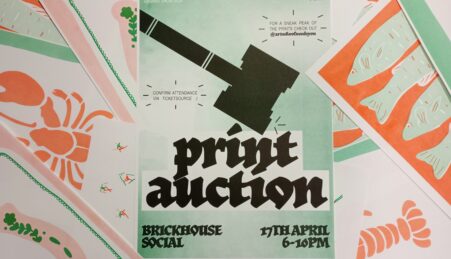
Humanity Hallows Issue 4 Out Now!
Pick up your copy on campus or read online
Over the last year, the Outreach team at Manchester School of Art have been working on a Peppered Moth project that has engaged with over 9000 people in the Manchester community and that has culminated in the recent launch of the book A Whisper To A Shout.
By Benjamin Francis Cassidy
The Peppered Moth is a species that was common in Manchester before industrialisation, and had white markings which prevented it from being seen by predators. Due to smog and factory smoke this changed and the species was thought to have died out around 1800, as birds could see it now that its wings were covered in soot.
130 years later to great surprise and celebration, the Peppered Moth was re-dicovered, and, having altered its markings, had evolved to ensure its survival. The moth thus became a symbol for the city of Manchester to change and adapt to post-industrialism. It also became a metaphor for the city’s status as part of the so-called Northern Powerhouse of commerce and business.
Principal Lecturer at Manchester Met’s School of Art Jayne McFadyen opened proceedings at the book launch, by discussing how the project developed. She informed the audience that the book “includes all partners”, and is a “narrative around climate change”. What quickly became clear was that the project itself very much had a theme that reflected the book, and adopted creative approaches to awareness by encouraging cross subject co-operation. The feeling that all subjects are relevant to climate change and that nobody is immune to its effects and dangers was at the fore-front of the tone of the evening.
Jayne then introduced the School of Art Artist in Residence Ant Hamlyn. Ant’s installation sits proudly in the foyer of the art school. A response to the brief to get people thinking about climate change, Beautiful Sludge II is a large machine that drops black dye into clear liquid every two and a half hours, and which will eventually turn the liquid black. The effectiveness of the idea also means that, as Jayne said, “Ant has demystified what it is to be an artist today”, by justifying such a role and the part it can play in society for positive change.
Ant added that science and art are “not separable” and “people always seem to want to categorise so much.” Ant’s attitude and his creation challenge this mindset and comment on the delivery of art and its consumption too, as Beautiful Sludge II is non-static art.
Anna Frew and Ellie Simms led the project. Anna was very specific in what she gained from the experience, stating, “The cycle of learning and the project has transcended hierarchies, meaning that everyone is valued, as well as their views and input.” Ellie expressed similar opinions, saying how pleased she was that “Narrative strands could be born from one symbol.” She added, “The importance of people communicating and creating has been able to be show-cased.”
A special guest on the night was Senior Lecturer in Science Communication Sam Illingsworth. Sam performed a poem he had written called ‘The Peppered Moth’, which immortalised this fascinating story. Everyone present applauded his work, and listened with great interest and appreciation. Another example of science and art in dialogue.

Outreach team Manchester School of Art
Other prominent science academics also attended the event. Professor of Microbiology and Head of the university’s Science and Engineering Departments Joanna Verran pointed out that Manchester was named 2016 European City of Science. Joanna explained, “Peppered Moths are a perfect example of how to combine science and humanities.” She also told guests that a ‘whisper’ is the collective noun used for moths.
Also on hand was Lecturer in Biology Dr Emma Coulthard. Emma completed her PhD thesis on moth ecology, and wants people to know more about moths. For example, there are around 2500 species of them in the UK, compared to 59 species of butterfly. Yet, the moth continues to be viewed as the poor relation. Emma advised that small changes, such as thinking about what types of flowers you might plant to attract more moths, can make a real impact on conservation attempts. She also condemned the use of pesticides and herbicides, stating they are toxic to insects and can alter the food-chain by meddling with very complex dynamics within nature.
Audience member Amelia, who works for local children and family arts charity Z arts, in Hulme, commented on the multi-faceted learning potential of the project. She said, “This project is for everyone”. Another audience member August enjoyed the combination of illustration and poetry, commenting that this “gave things a vibrancy”.
The message of the event was a strong one with guests eager to find out what they could do to contribute, which in keeping with the ethos of the Peppered Moth team was to find as many ways to talk to as many people about our collective responsibility to reduce our carbon footprint and safeguard nature. This event was certainly an assured method to achieve that. As eye opening as it was fun, this project culminated in a fantastic evening and a great publication.
To receive a free copy of A Whisper to A Shout, visit the Manchester School of Art. To find out more, visit the School of Art website







Leave a reply